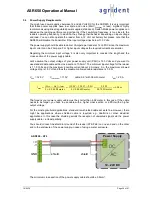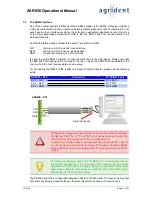
19/09/18
Page 6 of 67
ASR650 Operational Manual
1
Introduction
This manual is primarily written for OEM customers, distributors and
advanced users. It is not intended to be a document for end customers
since there are lots of details explained which are much too technical for
most end users.
Please read this manual carefully before using this product for the first time.
It will help you to get the best possible system performance and to use all
capabilities of the reader.
The equipment has to be installed by qualified personal only.
1.1
Definition of terms
Explanation of terms and abbreviations used in this manual
RF:
Radio Frequency (in this case the long-wave band)
RFID:
R
adio
F
requency
ID
entification - A method of transmitting data contactless
between a reader and transponders.
Reader:
A device which is able to communicate with transponders using an internal or
external antenna. The reader generates a high frequency field in order to get
the data of a transponder. The received data are transmitted to an external
controller (e.g. PC) via an interface.
Transponder:
Data carrier for RFID applications, available in various models and types.
Raw data:
Complete data content of a transponder - that means ID and additional
information (for example header or trailer).
ID:
Identification number of a transponder.
ISO 11784/85:
International standard concerning the use of RFID technology for the
identification of animals; it defines the transponder types to be supported and
the ID notation.
FDX:
Transponder type, which transmits its data while the RF field is activated (full
duplex) using AM (Amplitude Modulation).
FDX-B:
FDX transponder with 128 bits of raw data, ID notation in compliance with ISO
11784/85.
HDX:
Transponder type, which transmits its data after RF field switches off (half
duplex) using FSK (Frequency Shift Keying); 104 bits of raw data, ID notation
in compliance with ISO 11784/85.







































